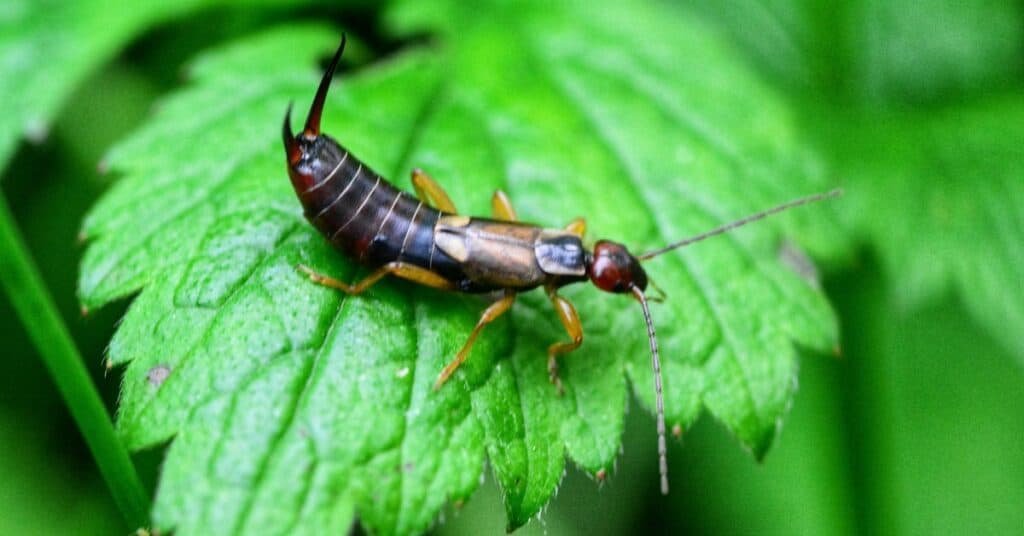Have you ever wondered how long earwigs can survive without food? Earwigs are fascinating insects that often evoke fear and curiosity due to their pincers. But have you ever wondered how these tiny creatures survive when food is scarce?

About Earwigs
Earwigs, scientifically known as Dermaptera, are nocturnal insects commonly found in gardens and damp areas around the world.
Like all living organisms, they require sustenance to fuel their activities and ensure survival. However, earwigs possess an incredible ability to adapt to challenging conditions and endure extended periods without food.
In general, under normal circumstances with access to available resources such as decaying plant matter or other insects, earwigs will feed regularly. They are omnivorous scavengers that primarily consume dead organic material but may also indulge in live prey or vegetation.
How Long to Live Without Food
There isn’t a straightforward answer to precisely how long an earwig can survive without food since it depends on various factors like temperature and individual resilience.
Studies suggest that some species have been able to withstand up to several weeks or even months under extreme circumstances.
When faced with unfavorable environmental conditions or limited food sources, earwigs can enter a state of torpor where they significantly reduce their metabolic rate. This adaptation allows them to conserve energy and prolong their survival even in the absence of regular meals.
So let’s dive deeper into the mechanisms behind an earwig’s ability to cope with prolonged starvation periods – it might surprise you!

The Life Cycle of Earwigs
Earwigs go through a series of developmental stages during their life cycle. Understanding the life cycle of earwigs helps us comprehend how these creatures thrive and adapt in different environments while ensuring successful reproduction for future generations.
Here’s an overview:
- Eggs: Female earwigs lay their eggs in underground burrows or crevices, typically during spring or early summer. These eggs are small and oval-shaped.
- Nymphs: After a few weeks, the eggs hatch into nymphs, which resemble miniature versions of adult earwigs but lack wings and are lighter in color. Nymphs molt several times as they grow, shedding their exoskeleton to accommodate their increasing size.
- Maturity: As the nymphs continue to molt and develop, they eventually reach adulthood within a few months. Adult earwigs have fully functional wings and can fly short distances if needed.
- Reproduction: Once matured, male earwigs engage in courtship behaviors to attract females for mating. This may involve elaborate displays such as antennal stroking or physical interactions like chasing each other.
- Parental Care: Unlike many other insects, female earwigs demonstrate maternal care by guarding their eggs until they hatch into nymphs. They also protect the young nymphs for some time after hatching by remaining nearby and providing limited assistance with feeding.
| Lifecycle Stage | Duration |
| Eggs | 10-14 days |
| Nymph | Several months |
| Maturity | Reached within months |
The exact duration of each stage varies depending on factors such as temperature and food availability.

Understanding the Feeding Habits of Earwigs
Earwigs, those peculiar-looking insects with pincers on their abdomen, may not be your favorite creatures to encounter in your garden or home. But have you ever wondered what these creepy crawlies feed on?
Understanding their feeding habits can help us develop effective strategies for managing earwig populations without causing harm to the ecosystem.
Here are a few key points to help you understand how earwigs obtain their nourishment:
- Omnivorous Diet: Earwigs are opportunistic eaters that exhibit an omnivorous feeding behavior. This means they consume both plant matter and various other organisms found in their environment.
- Plant Material: A significant portion of an earwig’s diet consists of plant material such as leaves, flowers, fruits, and seedlings. They can nibble on vegetation found in gardens or crop fields.
- Decaying Matter: Alongside fresh plant material, earwigs also feed on decaying organic matter like fallen leaves or decomposing wood. This helps them break down dead plants while scavenging for nutrients.
- Insects and Small Arthropods: Earwigs opportunistically prey upon smaller insects and arthropods when given the chance. Their diet might include aphids, mites, spiders, insect eggs/larvae/pupae, millipedes centipedes ants among others.
- Scavengers by Nature: Being nocturnal creatures primarily active during nighttime hours means they often scavenge for food rather than actively pursue it themselves.
- Moisture Dependence: Not only do earwigs require sustenance from various sources but they also rely heavily on moisture-rich environments due to their susceptibility to desiccation (drying out).
Although earwigs can be considered pests at times due to damage caused by feeding activities – particularly to garden plants – they also play a role in natural pest control by consuming other insect pests.
| Key Takeaways |
|---|
| Earwigs are omnivorous, feeding on both plant material and other organisms like insects and small arthropods. |
| They consume decaying organic matter as well and can be considered valuable decomposers. |
| Being nocturnal scavengers, earwigs rely on moist environments for survival. |
By gaining insights into what drives an earwig’s appetite, we can better comprehend their behavior patterns and coexist with these intriguing creatures more harmoniously.
Common Misconceptions about Earwig Survival without Food
When it comes to earwigs and their ability to survive without food, there are several common misconceptions that need to be addressed. Let’s shed some light on these misunderstandings:
- Earwigs can survive for months or even years without food Contrary to popular belief, earwigs cannot survive for extended periods of time without a source of nourishment. While they do have the ability to withstand longer periods of fasting compared to other insects, their survival is limited.
- They solely rely on stored fat reserves during periods of scarcity Although earwigs can store small amounts of fat reserves in their bodies, these reserves are not sufficient for long-term survival. While they may tap into these stores during times when food is scarce, this strategy alone cannot sustain them indefinitely.
- Earwigs hibernate or enter a state of dormancy when deprived of food Unlike some animals that go into hibernation or undergo dormancy during harsh conditions, earwigs do not possess such mechanisms. They remain active throughout the year and require a constant supply of food for sustenance.
- Their slow metabolism allows them to survive longer without eating While it is true that earwigs have relatively low metabolic rates compared to other insects, this does not translate into an exceptional ability to survive extended periods without feeding. Their metabolism slows down in response to reduced energy intake but cannot compensate indefinitely.
- Survival strategies vary between different species of earwigs It’s important to note that different species may exhibit varying degrees of resilience when faced with starvation; however, all species ultimately require regular access to food sources in order to thrive and reproduce successfully.
Earwig Survival Without Food
Factors Affecting Earwig Survival Without Food
When it comes to surviving without food, earwigs are quite resilient. However, several factors can influence how long they can go without a meal. Here are the key factors that affect earwig survival without food:
- Species: Different species of earwigs have varying abilities to withstand periods of food scarcity. While some species can survive for weeks or even months without eating, others may struggle after just a few days.
- Age and Health: The age and overall health of an earwig play a role in its ability to survive without food. Younger and healthier individuals tend to have more energy reserves stored in their bodies, allowing them to last longer during times of famine.
- Environmental Conditions: The surrounding environment greatly impacts an earwig’s ability to find alternative sources of sustenance apart from their regular diet which mainly consists of decaying plant matter or other insects. If suitable resources like moisture or shelter are available, earwigs may be able to endure longer periods with limited access to food.
- Seasonal Variation: Earwigs’ ability to survive without food also varies depending on the time of year. During warmer seasons when there is abundant vegetation or insect prey available, they may be able to sustain themselves for extended periods compared to colder months when resources become scarce.
- Hibernation Behavior: Some species exhibit hibernation-like behaviors during harsh conditions such as winter or droughts when finding nourishment becomes challenging. By entering a state of dormancy called diapause, earwigs reduce their metabolic rate and conserve energy until better feeding opportunities arise.
- Body Size: Generally speaking, larger-sized adult earwigs tend to have more fat reserves than smaller individuals due to their increased body mass capacity for storage purposes; this allows them greater chances of enduring prolonged fasting periods compared with their smaller counterparts.
Remember: While earwigs are capable of surviving without food for a period of time, it is crucial to provide them with appropriate nutrition when keeping them as pets or managing their populations.
How Long Can Young Earwigs Survive Without Food?
Young earwigs, also known as nymphs, have slightly different survival capabilities compared to adult earwigs. Here’s what you need to know about how long young earwigs can live without food:
- Survival time: Young earwigs are more resilient than their adult counterparts and can survive for shorter periods without food.
- Shorter lifespan: Nymphs have a shorter lifespan in general, which means they require less sustenance overall.
- Energy reserves: Like all living organisms, young earwigs rely on energy stored within their bodies for survival when food is scarce.
- Feeding habits: Nymphs typically feed on the same types of organic matter as adults—decaying plant material, insects, and small arthropods—but in smaller quantities due to their size and energy requirements.
Although specific numbers regarding the exact duration that young earwigs can survive without food may vary depending on environmental conditions and individual circumstances, it is generally accepted that:
- Under favorable conditions with access to water: Young earwigs can potentially survive for up to several weeks without a meal.
- During unfavorable conditions or extreme temperatures: The survival time decreases significantly.
Remember: While young earwigs possess some ability to endure longer periods without nourishment compared to other insects, providing them with a suitable habitat with abundant food sources will contribute positively towards their growth and development.
Survival Strategies for Adult Earwigs During Food Scarcity
During periods of food scarcity, adult earwigs employ various survival strategies to ensure their survival. Here are some key strategies they use:
- Reduced Activity: When food becomes scarce, adult earwigs reduce their activity levels to conserve energy. They become less active and spend more time hiding in dark crevices or underground.
- Longevity: Adult earwigs have the remarkable ability to survive for extended periods without food. Some species can endure up to several weeks or even months without consuming any sustenance.
- Feeding on Non-Food Materials: In desperate situations, adult earwigs may resort to feeding on non-food materials such as plant debris, decaying matter, or even other insects if necessary.
- Cannibalism: In extreme cases of food shortage, adult earwigs may turn cannibalistic and feed on weaker individuals within their population.
- Hibernation-like State (Diapause): During exceptionally harsh conditions like winter or droughts when food is scarce for an extended period, some species of adult earwigs enter a hibernation-like state called diapause. This allows them to conserve energy until favorable conditions return.
It’s important to note that while these survival strategies help adult earwigs withstand short-term periods of food scarcity, long-term starvation can severely impact their overall health and reproductive capacity.
| Survival Strategy | Description |
|---|---|
| Reduced Activity | Adult earwigs limit their movement and stay hidden in dark places during times of limited food availability |
| Longevity | Some species can survive without eating for several weeks or months |
| Feeding on Non-Food Materials | When resources are scarce, adults will consume alternative sources such as plant debris or decaying matter |
| Cannibalism | In dire situations, adult earwigs may resort to cannibalism and prey on weaker individuals within their own population |
| Hibernation-like State | During harsh conditions like winter or droughts, certain species enter diapause – a hibernation-like state where metabolism slows down, allowing them to conserve energy until more favorable conditions return |
Understanding these survival strategies can provide valuable insights into the adaptability and resilience of adult earwigs in challenging environments. By adopting these tactics, they can increase their chances of surviving periods of food scarcity.
Note: This article provides general information about the topic discussed; however, if you encounter an infestation or suspect any issues related to pests like earwigs or others in your home or garden, it is recommended to consult a professional pest control service for appropriate advice and assistance.
Tips for Preventing an Earwig Infestation in Your Home
To keep earwigs from invading your home and garden, follow these simple tips:
- Eliminate moisture: Earwigs are attracted to damp areas, so it’s essential to address any sources of excess moisture in and around your house. Fix leaky pipes, ensure proper drainage, and use dehumidifiers if necessary.
- Seal entry points: Close off potential entryways by sealing cracks and gaps in windows, doors, walls, and foundations using caulk or weatherstripping. This will help prevent earwigs from finding their way indoors.
- Keep vegetation away: Trim plants that touch the exterior of your home as they can serve as bridges for earwigs looking to enter. Maintain a clear space between shrubs or trees and your house.
- Store firewood properly: If you have firewood near your home, make sure it is stored at least 20 feet away from the house and elevated off the ground. This discourages earwigs from nesting in the woodpile.
- Remove hiding spots: Regularly clean up debris such as leaves, mulch piles, rocks, or decaying plant matter where earwigs may seek shelter during daylight hours.
- Manage outdoor lighting: Bright lights near windows attract insects that serve as food for earwigs. Consider using yellow bug lights instead of white ones to minimize their attraction while still providing adequate illumination.
- Use barriers: Create physical barriers around vulnerable areas like planter boxes or raised beds with materials like diatomaceous earth or crushed eggshells which can deter crawling pests like earwigs.
- Practice good sanitation indoors: Keep indoor spaces tidy by vacuuming regularly and promptly cleaning up spills or crumbs that could provide a food source for wandering earwigs.
Remember: Prevention is key when it comes to keeping earwigs at bay. By implementing these simple tips, you can reduce the likelihood of an earwig infestation in your home and enjoy a pest-free environment.












